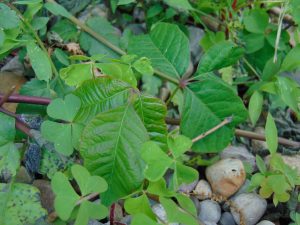
Poison Ivy Growing Among Woodsorrel
Whenever I take a walk around our house, I keep my eyes open for poison ivy. In the past couple weeks it seems to have awoke from its seasonal slumber and is ready to take off. The sooner you can control poison ivy the better. In order to control it well, it is important to understand this persistent plant.
The old saying “leaves of three, let it be” has been most helpful for me over the years to keep from getting confused between poison ivy and other look alikes. Poison ivy is a climbing woody vine that loses it’s leaves each winter. Leaves are egg shaped with three leaves per petiole that may be toothed, lobed, or entire. Poison ivy attaches to trees and rocks with aerial roots, which may have a hairy, fibrous appearance. Leaves may take on a reddish hue late in the season. It reproduces by creeping stems, roots, and seed transported by birds. Poison ivy can thrive in many areas that other plants do not.
All parts of the plant contain resins that cause allergic reactions for most of the U.S. population. These resins cause issues if burned, directly touched, or indirectly transferred from one surface to another. Resins are continually present on the leaves, stems, and roots, even in the winter.
Poison ivy is often confused with Virginia creeper, which is a creeping and trailing vine that secures itself to objects with specialized stems call tendrils. Virginia creeper has 5 leaflets, instead of three and is not poisonous. Poison oak is another common mix up. Poison oak has three leaflets, but the leaves look very similar to a classic oak leaf. The lobes have blunt tips and hairs on both the top and bottom of the leaf. Poison oak is not a creeping weed, but rather grows upright from the soil surface. For this plant the “leaves of three, let it be” statement still applies.
Poison ivy and poison oak are responsive to glyphosate, triclopyr, and 2, 4-D herbicides, which are commonly used in poison ivy killers. Always follow the label when using a herbicide and wear adequate protective gear while handling!



